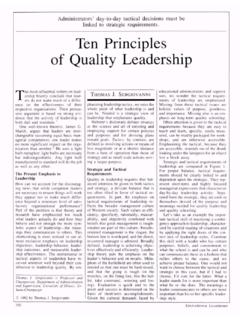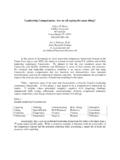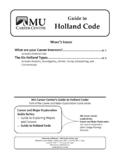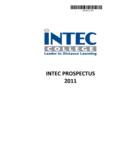Transcription of A Mixture of Art, Science, Processes, and Common …
1 CCoouurrtteessyy ooff:: SScciittoorr CCoorrppoorraattiioonn 225566 GGiibbrraallttaarr DDrriivvee SSuunnnnyyvvaallee,, CCAA 9944008899 880000//553333--99887766 Written by Harvey Levine Page 1 of 4 The Philosophy of Project Management A Mixture of Art, Science, Processes, and Common Sense. Writers often get typecast, just like actors. This was brought home to me last month when I read the endorsement statements that had been contributed by several of my colleagues in support of my latest book on project management ( Practical Project Management , John Wiley & Sons).
2 Several of these extremely kind statements noted my reputation as a project management tools expert, and almost seemed surprised that I had such extensive coverage of other project management topics. Readers of this whitepapers section of the Scitor website should not be similarly surprised, as I have attempted to discuss a very wide range of practices and issues associated with project management. In the final section of the aforementioned book, I present several chapters under the heading of Making Project Management Work.
3 Here are the opening paragraphs: Project Management is an ART. Project Management is a SCIENCE. Project Management is a PROCESS. Yes, it is all of these. But, most of all, Project Management is a lot of Common SENSE. Without organizing for project management and without establishing a set of project management practices, and developing a project management culture, project management is likely to fail. Yet, all of these are not enough to assure that any project management initiative will be successful. This is because project management cannot be solely an academic subject.
4 Rather, it must be the practical application of the accumulated theory, knowledge and experience about organizations, people, operations, and projects. In a nutshell, in order to successfully implement project management, there must be a sound, consistent, and reasonable philosophy of project management. Easy to say, of course, but much harder to accomplish. We are often slow to recognize the importance of project management as a way of life in the firm. There are still far too many executives who either fail to appreciate that business success is often dependent on project success, or that the management of projects and the management of operations are not two distinct and separate disciplines.
5 The single most prevalent obstacle to this goal (successful project management) is cultural. Culture is not an easy thing to change. But one thing is for certain. The change in culture must be directed and fully supported from the top. And this change must be implanted into the philosophy of all levels of management, if it is to eventually permeate the complete enterprise. For some practical guidance on this, read Jack- Straight from the Gut (Warner Business Books). Here, Jack Welsh tells (painfully) of how he learned to implant cultural change deep into the General Electric management hierarchy.
6 CCoouurrtteessyy ooff:: SScciittoorr CCoorrppoorraattiioonn 225566 GGiibbrraallttaarr DDrriivvee SSuunnnnyyvvaallee,, CCAA 9944008899 880000//553333--99887766 Written by Harvey Levine Page 2 of 4 What are the changes that we want to bring about, to implant a project management culture? They include the following: Tear Down the Walls It would be appropriate at this point to note the comments made by Rosabeth Moss Kanter, in her book: The Change Masters (Simon & Schuster, 1983). Here, she identifies segmentalism as a key obstacle to change and innovation.
7 My experiences support this premise. The culture of project management calls for a significant reduction in the artificial barriers that often develop within the enterprise. Managers take ownership of their disciplines, rather than the results. More often than not, this leads to a blockage of support rather than contributing to success. This cannot be allowed to exist in a successful project management culture. In this day and age, we have come to recognize knowledge power as being more important than position power.
8 This has led to the development of temporary teams to meet the needs of temporary projects. The personnel forming these teams are chosen for their ability to contribute to the project results, rather than their position in the hierarchy. Flexibility, adaptability, and openness are the hallmarks of this new project culture. Bridge the Gaps Segmentalism is the cause of another obstacle to project success. As each discipline in the organization minds its own store, too many things fall through the cracks. One of the most egregious gaps is that which traditionally exists between the venerable Operations function and the newer Projects function.
9 Each function views its role differently. The Operations people focus on Objectives, Goals, Strategies, Project Selection & Mix, and Cash Flow. The Projects people concentrate more on Schedules and Time, Project Cost, Performance, Stakeholder Satisfaction, and Scope/Change Control. True project success requires that the gap between these two essential groups be bridged. Tools exist to facilitate this connection. But first, the culture must change to promote a partnership between these functions. The projects people have to realize that projects may not be an end, but rather a means to achieve the firm s larger objectives.
10 Thus, the management of such projects cannot be performed in isolation, but rather as part of the overall strategic operation. Likewise, the operations people need the success of projects to achieve the firm s strategic goals. They need to be active in communicating these goals, and the operating conditions, to the people responsible for the projects. And they need to be active in monitoring the project activity and in contributing to strategic decisions and solutions. CCoouurrtteessyy ooff:: SScciittoorr CCoorrppoorraattiioonn 225566 GGiibbrraallttaarr DDrriivvee SSuunnnnyyvvaallee,, CCAA 9944008899 880000//553333--99887766 Written by Harvey Levine Page 3 of 4 Take Risks and Manage Them It s difficult to find the middle ground on risk.










